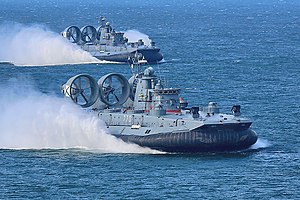
Back Projekt 1232.2 Czech Pomornik-klassen Danish Pomornik-Klasse German Zubr (αερόστρωμνο αποβατικό) Greek السیایسی کلاس زوبرا Persian Classe Zoubr French Classe Pomornik Italian ポモルニク型エアクッション揚陸艦 Japanese 주브르급 공기부양상륙정 Korean Малые десантные корабли на воздушной подушке проекта 12322 Russian
 Mordoviya and Evgeniy Kocheshkov
| |
| Class overview | |
|---|---|
| Builders | PO More in Feodosiya of Crimea, Khabarovsk shipyard, Almaz, Pribaltisk Yantar |
| Operators | |
| In commission | 1986–present |
| Planned | 17[1] |
| Building | 2[1] |
| Completed | 15 |
| Cancelled | 2 |
| Active | 10 |
| Scrapped | 5 |
| General characteristics | |
| Type | Air-cushioned landing craft |
| Displacement |
|
| Length | 57 m (187 ft)[2] |
| Beam | 25.6 m (84 ft)[4] |
| Draught | 1.6 m (5.2 ft)[2] |
| Propulsion |
|
| Speed | |
| Range | 300 nmi (560 km) at 55 knots |
| Complement | 31 (4 officers, 27 enlisted)[3] |
| Sensors and processing systems | Ekran-1 navigational radar, Lazur radar (Pozitiv radar on MDK-51), R-782 Buran communications system |
| Electronic warfare & decoys | Electronic Countermeasures System: Decoys, MS-227 chaff launcher, MP-411 ESM radar system; intercept |
| Armament |
|
The Zubr class, Soviet designation Project 1232.2, (NATO reporting name "Pomornik") is a class of Soviet-designed air-cushioned landing craft (LCAC). The name "Zubr" is Russian for the European bison.[5] This class of military hovercraft is, as of 2023 the world's largest hovercraft,[6] with a standard full load displacement of 555 tons.[3][7] The hovercraft was designed to sealift amphibious assault units (such as marines and tanks) from equipped/non-equipped vessels to non-equipped shores, as well as to transport and plant naval mines.
Ten Zubr-class hovercraft remain in service. There are two vessels in the Russian Navy and four with the Hellenic Navy.[4] In 2009 China placed an order for four vessels from Ukraine as part of a deal worth US$315 million.[8] Two updated versions of the vessels were built by Crimea's Feodosia Shipbuilding Company, followed by two advanced models of the surface warship.[8][9] In 2023, an additional two more were built and modernized, with both hulls being numbered as 3260 and 3261.[1]
The purchase in 2000 of HS Cephalonia (L 180) for the Hellenic Navy marked the first time a Soviet-designed naval craft had been built for a NATO member.[10][11][12][13]
In June 2017 Russia announced the restarting of production of Zubr-class craft.[14] Representatives from the Russian shipbuilding industry soon after responded by stating production could not possibly resume in 2018 and would only be possible by 2019–2021, refuting the government position. Representatives cited the lack of availability of and inability to mass-produce components, notably gas-turbine engines and reduction gears as the main obstacles.[15]
NPO Saturn (ODK GT) and Turboros developed marine gas turbine engines M70FRU (D090), FR RU, M70FRU2 (DP/DM71) along M90FR, M75RU, E70RD8 and Elektrosila, AO Zvezda, Metallist, Samara and others developed redactors and gears.[16][17]
- ^ a b Jane's Information Group (2002).
- ^ a b c d e Wertheim (2007), p. 128.
- ^ a b "Zubr Class (Pomornik) Air Cushioned Landing Craft, Russia". Naval-Technology.com. 2011. Retrieved 2 August 2011.
- ^ зубр Russian Wiktionary
- ^ Wilkinson, Freddie. "Guinness world record hovercraft". Guinness world record.
- ^ "Hellenic Command Amphibious Forces: Ships". Hellenic Navy. 2008. Archived from the original on 4 August 2008. Retrieved 18 April 2009.
- ^ a b Rahmat, Ridzwan (6 March 2014). "Ukraine crisis prompts hurried delivery of second Zubr LCAC to China". IHS Jane's. Archived from the original on 2 August 2014. Retrieved 5 January 2015.
- ^ "China To RePay $14 Million Debt To Crimea For Zubr-class Landing Craft". Defenseworld.net. 29 January 2015. Retrieved 5 December 2017.
- ^ "Hellenic Command Amphibious Forces: Introduction". Hellenic Navy. 2008. Archived from the original on 9 March 2009. Retrieved 18 April 2009.
- ^ Kitov, Vladimir (4 November 2000). "Almaz launches NATO-bound craft". The Russia Journal. Archived from the original on 12 March 2016. Retrieved 18 April 2009.
- ^ Titova, Irina (29 December 2000). "City Shipyard Hovercraft Is 1st Delivery to NATO State". The St. Petersburg Times. Archived from the original on 5 June 2011. Retrieved 18 April 2009.
- ^ "Russian ship joining Greek navy". BBC News. AVN Military News Agency. 20 December 2000. Retrieved 18 April 2009.
- ^ Jones, Bruce (16 June 2017). "Russia to resume construction of Zubr hovercraft". IHS Jane's 360. Archived from the original on 16 June 2017. Retrieved 16 June 2017.
- ^ "Production of Zubr-Class Air-Cushion Ships Resumes Only in 2019-2021, Shipbuilders Say". Mil Today. 18 June 2017. Archived from the original on 19 June 2017. Retrieved 19 June 2017.
- ^ "Россия полностью заменила украинские комплектующие для военной техники" [Russia has completely replaced Ukrainian components for military equipment]. Armstrade.org (in Russian). 14 September 2018.
- ^ "ОДК закрыла потребность флота в двигателях, ранее поставлявшихся Украиной" [UEC closed the fleet's need for engines previously supplied by Ukraine]. Armstrade.org (in Russian). 9 September 2019.